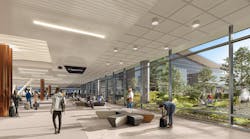If the pandemic reminded us of anything, it’s the immutable truth that change is constant. Managing client expectations has always been a challenge for architects and designers, but in a post-pandemic world, it’s almost as if things have shifted into a higher gear.
Expectations of the built environment have never been greater, and perhaps nowhere is this as obvious as in the design of public spaces like airports. These high-traffic buildings need to balance a multitude of requirements that demand thoughtful programming, but now, there are added layers to what travelers need to feel safe as they pass between destinations.
What do clients expect of design practitioners today, and how can architects and designers better manage the seemingly ever-changing world around them? And how have these new sets of expectations influenced the design of airports? i+s recently posed these questions to Pierluca Roccheggiani, U.S. design director and vice president of luis vidal + architects, to find out how designers and architects can navigate these changing and challenging times.
i+s: How have client expectations of architects and interior designers changed in recent years? Are expectations higher than before? If so, why?PR: More emphasis has been placed on mental well-being following the onset of the COVID-19 pandemic. Travelers are increasingly looking for specific areas dedicated to relaxation and calmness, like yoga rooms and meditation areas. Bringing natural light and open buildings to exterior views plays an important role in the whole passenger experience and help intuitive wayfinding. Another design aspect that has been increasingly sought-after post-pandemic is access to outdoor space. It’s becoming a vital component for comfort and well-being. We considered these factors when in primis, we designed the first post-COVID terminal in the United States—Pittsburgh International Airport Terminal Modernization Program.
i+s: What are the challenges associated with managing expectations, and how can designers under-promise and over-deliver?
PR: An architect’s job goes beyond design. From the start of working with a client on a project, the key to managing expectations is to have an open dialogue about plans and expectations.
i+s: Given your extensive experience in designing airports, what are the expectations in this market, specifically?
PR: The past few years have generated enormous changes in our day-to-day lives, and architecture must match these advancements. The pandemic has been quite challenging for air travel and has spotlighted outdated airport design and practices. We are witnessing the birth of new technologies and architectural design that improve operational efficiency and flexibility while keeping passengers’ health, safety and freedom as top priorities.
One significant challenge that U.S. airports are facing post-pandemic is how to expand. For various reasons, no new airports have been built from the ground up in the U.S. since Denver International Airport opened in 1995. New terminals will be designed and constructed soon, thanks to the Federal Infrastructure Bill. From a public investment standpoint, this enormous change of scale brings boundless possibilities—but also a big responsibility—to architects and engineers. We must take care of the environment, minimize the carbon footprint, enhance the passenger experience and bring nature and natural light into the buildings.
Actually, U.S. President Biden gave a speech [recently] about incoming transportation infrastructures from Boston Logan International airport’s terminal E modernization, in which we play an important role.
i+s: How is the design of airports changing in response to client expectations today? What are they looking for?
PR: Social norms around personal space are rapidly changing, and airport design is becoming holistically centered around the passenger experience and well-being. Travel now requires high-grade air quality, incorporating advancements in technology and architecture that allow optimal airflow and enough room for travelers to maintain comfortable distances. Travelers want space and safety. Further, clients are embracing new technologies. Both as a result of the pandemic and just innovation in general, we’ve grown accustomed to digital tools that provide additional layers of safety and security. These security and public health-related systems will become the norm in our airports.
One of luis vidal + architects’ projects that incorporate cutting-edge developments throughout the airport to improve travelers’ experience is the Terminal D gate at Dallas-Fort Worth International Airport, in which our team added innovative technologies that demonstrate the future of airport design. For example, the space is designed with state-of-the-art “View” glass facades facing the airport's runways, providing a feeling of spaciousness and comfort. The new glass technology allows the airport to use the facade as a communication tool, showing flight details and airport alerts.


